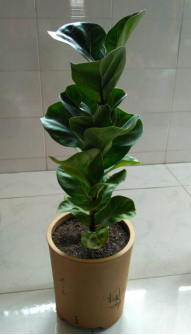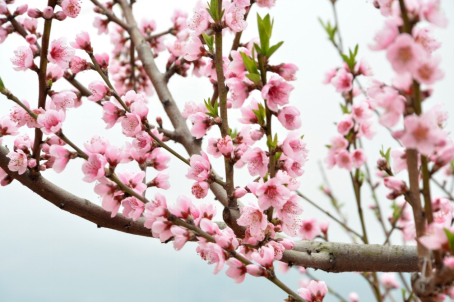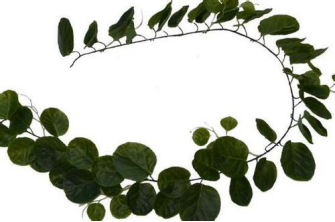How to cut the banyan leaves?
1. Cut the cuttings.
When cutting banyan leaves, it is best to choose one-to two-year-old branches, cut them 20 or 30 centimeters away from the basin soil, and then cut the cut branches into three or four to four segments as cuttings, leaving a leaf for each cuttage and cutting off about 2/3 of the leaves, which can reduce water evaporation.
2. Cuttings take root.
Soak the cuttage wound of the treated leaves in water or apply some plant ash to the wound to stop the sap from flowing out, and then insert the cuttings into a cutter made of river sand or perlite, paying attention to maintaining the temperature and air humidity in the environment. Generally speaking, in an environment of 27 or 8 degrees, roots can take place in about a month. After growing roots, you can transplant them into flowerpots for maintenance and growth.

Picture of Ficus lyrata figs: how to cultivate banyans / how to propagate banyan banyan name card figs Ficus lyrata banyan introduction to banyan banyan, also known as fiddle rubber tree, due to the expansion of the leaf tip to take the shape of a violin, is an evergreen tree of the genus Ficus mulberry. Qin leaf banyan can be up to 12 meters high, the stem is erect, rarely branched, the leaves grow densely, the leaves are thick leathery, dark green, shiny, sunken veins and short internodes. Qin leaf banyan has high ornamental value and is an ideal foliage plant in the hall. Morphological characteristics of Qin leaf banyan, also known as: milk tree, rat milk tree, milk tree, bone wind wood, iron cow into stone, milk wood. Deciduous shrubs. It is 1 to 2 meters high. Branchlets and petioles are white pubescent when young, later glabrous, often reddish purple. Simple leaves alternate, very variable, violin-shaped or Obovate, 4-10 cm long and 1.5-4.5 cm wide, base rounded or broadly cuneate, apex protruding, middle often more or less contracted into a narrow waist, both surfaces glabrous, sometimes pubescent below, stalk 4-8 mm long, inflorescence receptacle solitary or axillary in pairs, short pedunculate, ovoid or pear-shaped, fuchsia when hot, 10 mm in diameter, with navel-shaped protuberance at the top. There are bracts 3 at the base, male flowers and gall flowers grow together in one inflorescence receptacle, female peanuts in another inflorescence receptacle, perianth 4, style lateral. The ecological habits of Ficus chinensis prefer warm, humid and sunny environment, the optimum temperature for growth is 25 ℃ to 35 ℃, dormancy is about 15 ℃, and more than 5 ℃ can survive the winter safely. The requirement for moisture is that it is better to be wet than dry. Native to Sierra Leone to Morocco in West Africa, lowland rainforests are widely cultivated in tropics, subtropics, indoor temperatures and greenhouses. Without the introduction of a specific pollination banyan Xiaofeng, it will not become an invasive plant. The plant of origin can be up to 12 meters high, but the growth of indoor cultivation is slow, and the plant can be very small. The height of the terminal bud can be controlled by pruning, and the plant size can be controlled by small pot cultivation. Leaves up to 30 cm long, 6 cm wide, smooth, dark green, veins obvious, can be wiped with a wet cloth to keep moist and beautiful. Change the basin in spring and trim it in winter. The basin should be small, but heavy. This kind of tree is easy to be top-heavy, so it is necessary to prevent the flowerpot from falling. Too much or not enough water will lead to yellowing of leaves. The bottom of the basin needs to be perforated to maintain good drainage, once thoroughly watered, and the next time it can be watered until the soil is dry. There is plenty of light but not direct light. Potted plants can be rotated 90 degrees a week to receive light evenly. The distribution area of fir leaf banyan originates from Africa and is available on the market. Note the difference: this species (Ficus lyrata), also known as "Daqin leaf banyan", is not traditionally known as Ficus pandurata. Ficus pandurata is wild in China. Main distribution areas: Anhui, Fujian, Guangdong, Guangxi, Guizhou, Hainan, Henan, Hubei, Hunan, Jiangxi, Sichuan, SE Yunnan, Zhejiang, Thailand, Vietnam. Cultivation techniques of Ficus chinensis the propagation of Ficus chinensis is mainly by cutting, striping and so on. With the development of tissue culture technology, tissue culture leaf banyan is produced on a large scale, and its quality is much better than that of cuttings, strong resistance and fast growth. Banyan leaves are generally propagated by cuttings or under high pressure. When cutting, select 1-2-year-old branches, cut them at 20ml / 30cm from the soil surface, cut them into 4 stem segments, as cuttings, leave a leaf for each cuttage, and cut off the leaves to reduce water evaporation; first soak the cuttings in water or touch the wounds with plant ash to avoid sap outflow. Cuttings are inserted in a bed made of river sand or perlite, and pay attention to keeping the temperature of the bed and high air humidity around it. It can take root in about a month under the temperature of 25 ℃ and 30 min. After the truncated plant, due to the destruction of its apical dominance, the hidden bud of the stem node can germinate new shoots and form a bifurcated tree, and the cuttings can be cut again after the new shoots are aged. The method of high-pressure propagation is also a common method for the reproduction of Ficus angustifolia. One part of peat soil, one part of garden soil and one part of river sand are commonly used in pot cultivation of banyan leaves, with a small amount of mature base fertilizer added at the same time. Because of its broad leaves and large amount of fertilizer, liquid fertilizer or granular compound fertilizer should be applied for 2 weeks in general, in order to promote plant growth and thick green leaves, and no fertilizer should be applied in late autumn and winter. The growth of figs in spring and summer is larger, and more water is needed, so it is necessary to give sufficient water and increase foliar spraying at the same time. Qin leaf banyan is suitable for growing in semi-shade environment, so as to avoid direct sunlight in summer, so as not to burn the leaves and lose their luster. But the light is too weak and the growth of the plant is weak, so it must be given brighter light in order to grow healthily. The growing season generally grows well under 50% shade. Compared with other banyan plants, the cold tolerance of Ficus is relatively weak, and the overwintering temperature is 8 ℃. In order to improve its cold resistance, in addition to controlling the amount of water in late autumn and winter, phosphorus and potassium fertilizer can be increased about one month before the coming of winter. Water and fertilizer management like wetting soil has a relatively large range of water requirements. The requirements of soil and fertilizer are not strict, and more than 20-20-20 flowers can be irrigated with calcium and potash fertilizer. In the last four months, the plant type has been relatively compact and large, and the fertilizer requirement has gradually increased. Available flowers more than 20-20-20 diluted 1000 times + 5000 times calcium nitrate + 5000 times potassium nitrate combined with irrigation, combined with calcium and potassium fertilizer can enhance the Lignification of the stem. Under temperature management, the suitable temperature for growth is 25 ℃ to 35 ℃, dormancy is about 15 ℃, and more than 5 ℃ can be safely overwintered. Double-layer heat preservation facilities can be used in winter, and the greenhouse should be sealed in time when the temperature drops to 22-24 degrees in winter afternoon. It can be planted in a simple shed in summer. Humidity management Qin leaf banyan leaves compared with the dismissal of the humidity requirements are not strict, humidity can be maintained at about 60%. Light management figs have strong adaptability to light and can grow well under bright scattered light. Direct sunlight should be avoided in summer, shade should be placed outdoors, and light should be increased in winter. The light is controlled at 20000-25000LX in spring, shading and ventilation should be strengthened because of high temperature, high temperature and high humidity in summer, and the temperature is lower in autumn and winter, and the light is controlled to 25000-30000Lx or all-day sunshine. Too much shade will be too long, the stem is thin, affecting the ornamental effect. The planting technology matrix is prepared to use loose, drained and ventilated imported peat of 5-40mm specification, break the peat and mix well with water. (standard of adding water: after mixing well with water, hold a handful of peat tightly and the water seeps from the fingers) to be planted in the cup. The peat consumption in each basin of 12cm basin is about 300ml, and a packet of 300L imported peat can hold about 1000 cups. [4] for re-used old pots, they must be soaked in potassium permanganate 1000 times solution for more than half an hour, then rinse with clean water and dry for use. Small potted plants are generally planted with 12cm size pots. When planting, first cushion the matrix around the 2cm at the bottom of the cup, and then move the sieve seedlings into the cup. The seedlings should not be planted too deep, and the base of the flat plant should be suitable; the medium is loose and tight, loading to the cup 9 minutes full, 1 plant / pot. Disease control and harm of banyan banyan blight occurred in varying degrees in the cultivation and introduction areas of figs. It harms the leaves and stems of Ficus chinensis, causing leaf death or the death of the whole plant. After the susceptible area of the symptomatic leaves, water-stained gray disease spots appeared, which increased rapidly, developed into dark brown and rotted. After the stem is infected, there are dark brown disease spots, such as the disease spot ring cutting the stem, the above part is withered. First, strengthen cultivation management and enhance plant disease resistance. It is suitable to choose sandy loam or loam for planting banyan, with good drainage, all-day or half-day sunshine, good ventilation, high temperature and no less than 10 ℃ in winter. Avoid continuous cropping in the nursery. Apply compound organic fertilizer to prevent partial application of nitrogen fertilizer. Put it in a semi-shady or moist place with plenty of light in summer. Indoor viewing should be placed in a bright and ventilated place for a long time. In winter, it is appropriate to put it in a warm, ventilated and sunny place indoors, not too much watering, keep the soil moist, pay attention to remove the dust on the leaf surface, and keep the leaf surface clean and dry. Second, potted plants should be quickly moved to ventilated and sunny places with sufficient light, the leaves should not be sprayed with water, and seriously diseased leaves should be cut off. Mildly diseased leaves can cut off the disease spot together with part of the healthy tissue, and then spray Duoduo solution to protect it, or spray 80% Dysen zinc wettable powder 500 times, 25% metalaxyl wettable powder 500 times, etc., pay attention to the rotational use of chemicals. Third, after the diseased and dead plants are removed, the soil should be disinfected by watering 1% copper sulfate or sprinkling raw lime powder. The garden use of Qin leaf banyan is tall, straight and unrestrained, the leaf is peculiar, the leaf tip is inflated in the shape of a violin, and the piano leaf banyan has high ornamental value. it is an ideal foliage plant in the hall, and it can also be used to decorate the hall or office. it is a more popular garden tree, street tree and potted tree at home and abroad, and it is very resistant to air pollution and dust. How do banyan trees reproduce? The Propagation method of Banyan Ficus
Ficus arborescens is a common indoor foliage plant with high ornamental. Therefore, many netizens will ask how Qin leaf banyan propagates. There are mainly two methods of cutting propagation and striping propagation of Ficus tomentosa. Next, let's take a look at the specific breeding methods of fir.
Picture: Qin Ye Banyan
I. Cuttage Propagation of Ficus chinensis
Select 1-2-year-old branches, cut them about 20-30 cm from the surface of the basin soil, and cut the stem segments into 3-4 nodes, which are used as cuttings, leaving a leaf on each cutting. at the same time, the leaves should be cut off about 2 times 3-3 times 4 to reduce water evaporation.
First of all, the cut should be soaked in water or lightly touched with plant ash to avoid the flow of sap. Then prepare the cuttings cultivated with river sand or perlite and insert the cuttings into them, paying attention to maintaining the appropriate temperature and high air humidity around you. Generally in 25-30 ℃ temperature, wait a month or so can take root. After truncation, the apical dominance of the plant was destroyed, the new shoots germinated from the hidden buds on the nodes of the stem, and could form a bifurcated tree. Cutting and cutting can be carried out after the new shoots are aged.
Picture: Qin Ye Banyan
2. Striping propagation of Ficus chinensis
Select the semi-lignified branches with strong growth in the lower part of the plant, gently bend them down and bury them in the soil, and be careful not to cause the branches to separate from the parent plant or cause damage and break. The top of the branch needs to be exposed to the soil surface and tied up with a small bamboo pole to facilitate its upright growth. Before pressing, it is necessary to peel the stem segment embedded in the soil in a ring, with a width of about 1cm. It is best to use aids to fix the place where the surface branches are buried in the soil to prevent the branches from bouncing up. After the striping work is completed, remember to keep the soil moist and ventilated so that it can take root after about 3-4 weeks, then it can be cut off from the mother plant and planted separately.
The above is the introduction of the breeding methods of Ficus chinensis. I hope it can be helpful to everyone!
- Prev

Maintenance of Peach Blossom Bonsai
Although peach blossoms do not have high requirements for fertilizer, but in the young tree stage, we should pay attention to control the amount of nitrogen fertilizer, otherwise the seedlings will grow crazy. After reaching the full fruit stage, nitrogen fertilizer should be applied incrementally in order to enhance the tree potential. In addition, peach blossoms are afraid of waterlogging and should be drained in time to prevent stagnant water from rotting roots. Peach orchards also need to weed frequently and keep the soil loose.
- Next

The reason for the yellowing of the leaves of money pocket
one。 In terms of soil, people are easy to get sick when they are not breathing smoothly for a long time, and so are plants. If you do not change the pot soil for a long time, it will cause the soil to harden and lead to poor growth of the roots. The root is in a state of shortness of breath for a long time, without oxygen, the root will gradually rot.
Related
- Fuxing push coffee new agricultural production and marketing class: lack of small-scale processing plants
- Jujube rice field leisure farm deep ploughing Yilan for five years to create a space for organic food and play
- Nongyu Farm-A trial of organic papaya for brave women with advanced technology
- Four points for attention in the prevention and control of diseases and insect pests of edible fungi
- How to add nutrient solution to Edible Fungi
- Is there any good way to control edible fungus mites?
- Open Inoculation Technology of Edible Fungi
- Is there any clever way to use fertilizer for edible fungus in winter?
- What agents are used to kill the pathogens of edible fungi in the mushroom shed?
- Rapid drying of Edible Fungi

